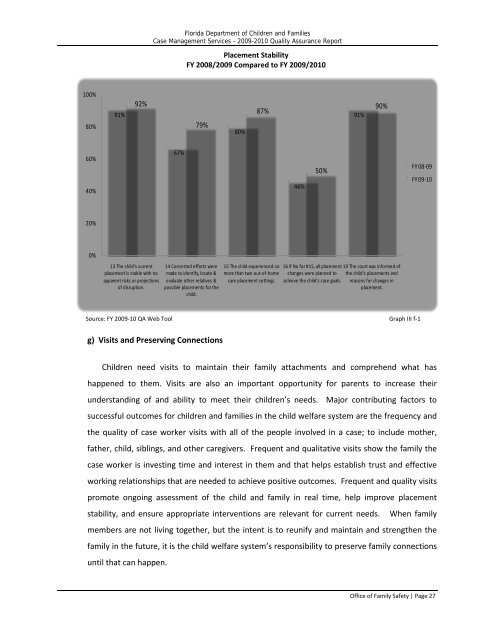Statewide Quality Assurance Report
Child Welfare Services Statewide Quality Assurance Report - Florida ...
Child Welfare Services Statewide Quality Assurance Report - Florida ...
- No tags were found...
Create successful ePaper yourself
Turn your PDF publications into a flip-book with our unique Google optimized e-Paper software.
Florida Department of Children and FamiliesCase Management Services - 2009-2010 <strong>Quality</strong> <strong>Assurance</strong> <strong>Report</strong>Placement StabilityFY 2008/2009 Compared to FY 2009/2010100%80%91%92%79%80%87%91%90%60%40%67%46%50%FY 08-09FY 09-1020%0%13 The child's currentplacement is stable with noapparent risks or projectionsof disruption.14 Concerted efforts weremade to identify, locate &evaluate other relatives &possible placements for thechild.15 The child experienced nomore than two out-of-homecare placement settings.16 If No for #15, all placementchanges were planned toachieve the child's case goals.19 The court was informed ofthe child's placements andreasons for changes inplacement.Source: FY 2009-10 QA Web Tool Graph III f-1g) Visits and Preserving ConnectionsChildren need visits to maintain their family attachments and comprehend what hashappened to them. Visits are also an important opportunity for parents to increase theirunderstanding of and ability to meet their children’s needs. Major contributing factors tosuccessful outcomes for children and families in the child welfare system are the frequency andthe quality of case worker visits with all of the people involved in a case; to include mother,father, child, siblings, and other caregivers. Frequent and qualitative visits show the family thecase worker is investing time and interest in them and that helps establish trust and effectiveworking relationships that are needed to achieve positive outcomes. Frequent and quality visitspromote ongoing assessment of the child and family in real time, help improve placementstability, and ensure appropriate interventions are relevant for current needs. When familymembers are not living together, but the intent is to reunify and maintain and strengthen thefamily in the future, it is the child welfare system’s responsibility to preserve family connectionsuntil that can happen.Office of Family Safety | Page 27

















